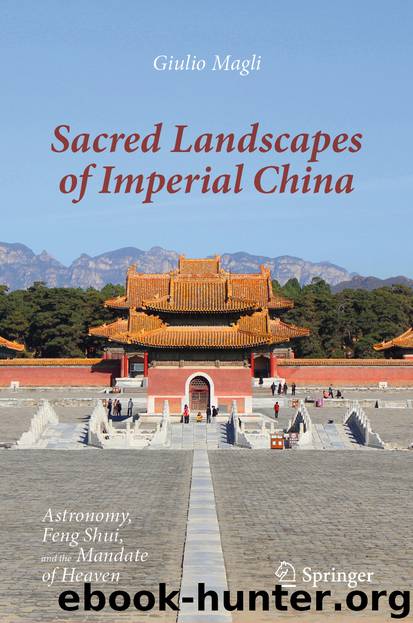Sacred Landscapes of Imperial China by Giulio Magli

Author:Giulio Magli
Language: eng
Format: epub
ISBN: 9783030493240
Publisher: Springer International Publishing
After Qianling, as many as sixteen other Tang emperors’ mausoleums were constructed. Some of these are of difficult access, to the point that in some cases the statues emerge from cultivated fields; farmers have been used to seeding the terrain avoiding the sculptures for centuries. The Spirit Paths are standardized: from south to north columns, winged animals, ostriches, guards of honor, horses with grooms, civil and military officials, gates guarded by lions. After proclaiming its connection with the afterworld through the winged animals, therefore, the standard Tang Spirit Road focused on real court life. However, the expression of the human figures remained solemn and distant to the observer, and the animals were depicted in static poses. The necessity of choosing peaks suitable for the construction of the spirit road led to the spread of the mausoleums along the Guanzhong Plain, extending some 150 km from the easternmost, Qianling, to the westernmost, Tailing (Gong and Koch 2002). In my view, they form a quite peculiar case of sacred landscape, since their “built” features are not inter-visible at all. Looking from the plain on a clear day, however, the long range of hills can be seen and so—provided that one knows that, but this knowledge was widespread—many mausoleums are actually seen at the same time. The specific orientation of each one can be defined by measuring the Spirit Path, which is always straight and—at least in most cases—does not depend on local topography. It is actually possible to measure the axes of thirteen imperial tombs, as well as those of the two imperial-style mausoleums. The azimuths, looking along the path in the direction of the tomb, are given in Table A.2. The following observations can be made:
1.The first mausoleum, as already mentioned, is actually a mound in Han style, and it is oriented cardinally.
Download
This site does not store any files on its server. We only index and link to content provided by other sites. Please contact the content providers to delete copyright contents if any and email us, we'll remove relevant links or contents immediately.
Kathy Andrews Collection by Kathy Andrews(11737)
The remains of the day by Kazuo Ishiguro(8832)
Paper Towns by Green John(5093)
Spare by Prince Harry The Duke of Sussex(5078)
Industrial Automation from Scratch: A hands-on guide to using sensors, actuators, PLCs, HMIs, and SCADA to automate industrial processes by Olushola Akande(5001)
The Body: A Guide for Occupants by Bill Bryson(4978)
Machine Learning at Scale with H2O by Gregory Keys | David Whiting(4200)
Be in a Treehouse by Pete Nelson(3955)
Never by Ken Follett(3800)
Harry Potter and the Goblet Of Fire by J.K. Rowling(3776)
Goodbye Paradise(3730)
Into Thin Air by Jon Krakauer(3315)
The Remains of the Day by Kazuo Ishiguro(3296)
The Cellar by Natasha Preston(3265)
Fairy Tale by Stephen King(3229)
The Genius of Japanese Carpentry by Azby Brown(3228)
120 Days of Sodom by Marquis de Sade(3185)
Drawing Shortcuts: Developing Quick Drawing Skills Using Today's Technology by Leggitt Jim(3001)
The Man Who Died Twice by Richard Osman(2998)
